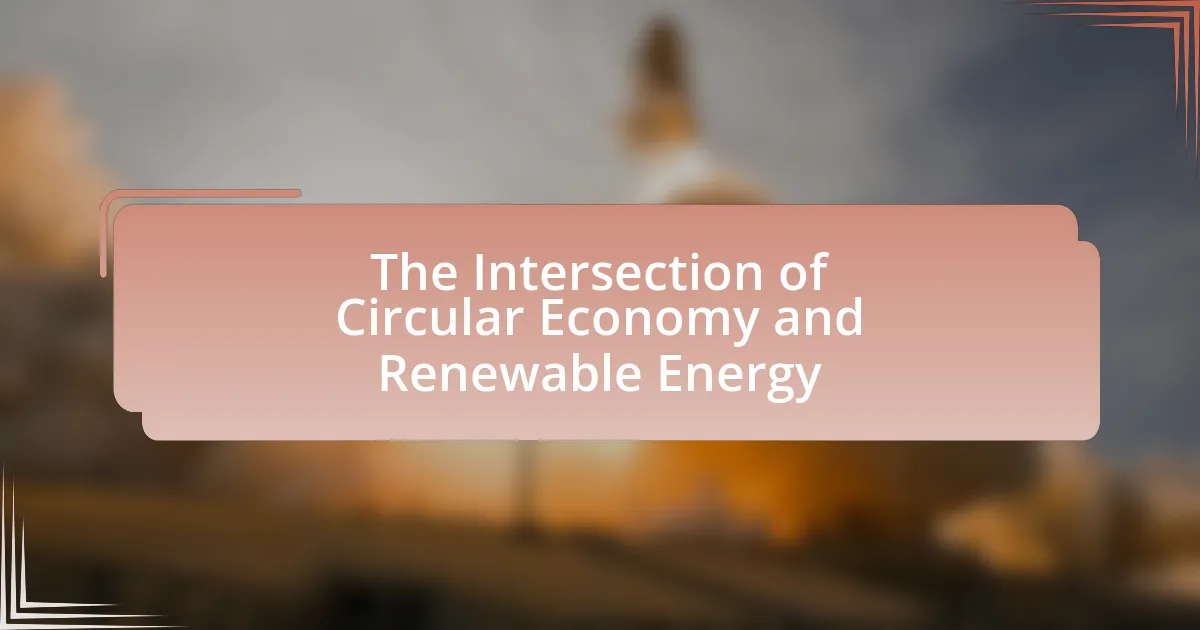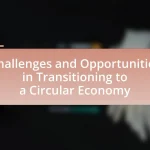The article focuses on the intersection of circular economy and renewable energy, emphasizing the integration of sustainable resource management with energy production systems that minimize waste and enhance resource efficiency. It outlines how circular economy principles, such as reuse and recycling, align with renewable energy practices, including the use of sustainable sources like solar and wind. Key components discussed include resource efficiency, waste reduction, and lifecycle management, highlighting the environmental and economic benefits of this synergy. The article also addresses challenges in implementing circular economy practices within the renewable energy sector and explores strategies for overcoming these barriers through collaboration, innovation, and effective regulatory frameworks.
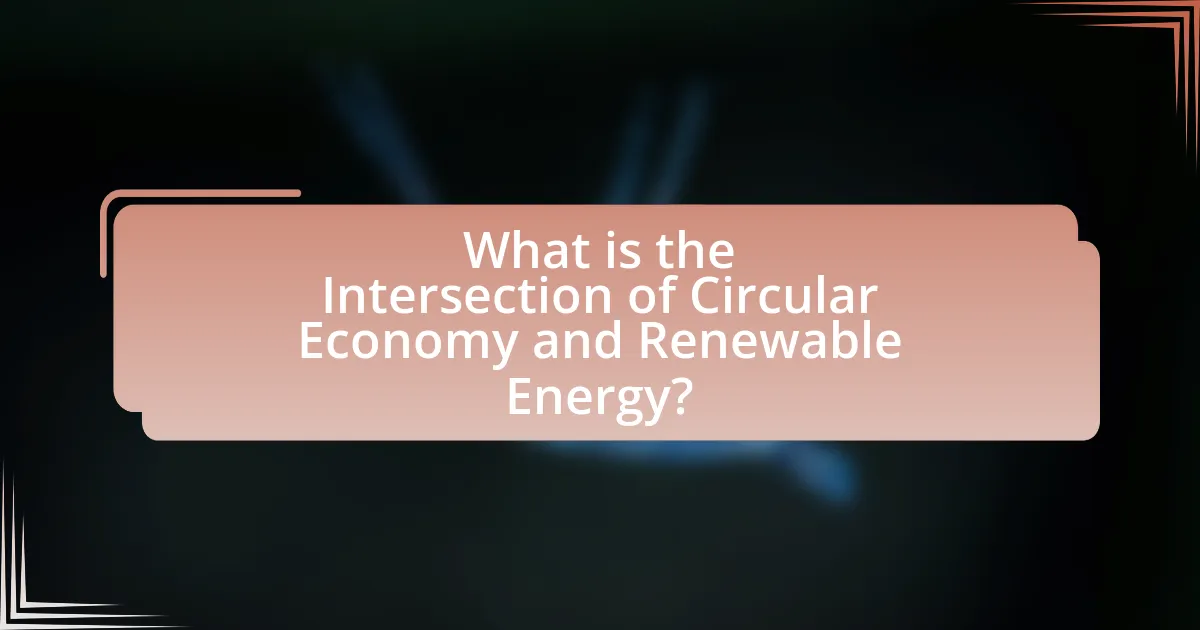
What is the Intersection of Circular Economy and Renewable Energy?
The intersection of circular economy and renewable energy lies in the integration of sustainable resource management and energy production systems that minimize waste and promote resource efficiency. Circular economy principles advocate for the reuse, recycling, and regeneration of materials, which aligns with renewable energy practices that focus on sustainable energy sources like solar, wind, and biomass. For instance, utilizing waste materials from renewable energy systems, such as solar panel recycling, exemplifies how circular economy strategies can enhance the sustainability of energy production. This synergy not only reduces environmental impact but also fosters economic resilience by creating new business opportunities in the renewable energy sector.
How do Circular Economy principles integrate with Renewable Energy?
Circular Economy principles integrate with Renewable Energy by promoting resource efficiency and sustainability throughout the energy lifecycle. These principles encourage the design of renewable energy systems that minimize waste, enhance resource recovery, and support the reuse and recycling of materials. For instance, the use of recycled materials in the manufacturing of solar panels reduces the demand for virgin resources and lowers the carbon footprint associated with production. Additionally, renewable energy technologies, such as wind turbines and solar panels, can be designed for disassembly, allowing for easier recycling at the end of their life cycle, thereby aligning with Circular Economy goals. This integration not only supports environmental sustainability but also fosters economic resilience by creating new business models focused on resource recovery and sustainable practices.
What are the key components of Circular Economy in relation to Renewable Energy?
The key components of Circular Economy in relation to Renewable Energy include resource efficiency, waste reduction, and lifecycle management. Resource efficiency emphasizes maximizing the use of renewable resources, such as solar and wind energy, to minimize reliance on finite fossil fuels. Waste reduction focuses on designing energy systems that minimize waste generation, promoting recycling and repurposing of materials used in renewable energy technologies, such as solar panels and wind turbines. Lifecycle management involves assessing the environmental impact of renewable energy systems from production to disposal, ensuring that materials are reused or recycled at the end of their life cycle, thereby closing the loop in energy production and consumption. These components collectively contribute to a sustainable energy future by reducing environmental impact and promoting the responsible use of resources.
How does Renewable Energy support Circular Economy initiatives?
Renewable energy supports circular economy initiatives by providing sustainable energy sources that reduce waste and promote resource efficiency. For instance, solar and wind energy systems can be designed for longevity and recyclability, minimizing environmental impact. According to the International Renewable Energy Agency, transitioning to renewable energy can lead to a reduction of greenhouse gas emissions by up to 70% by 2050, which aligns with circular economy principles of minimizing waste and maximizing resource use. Additionally, renewable energy technologies often utilize materials that can be repurposed or recycled, further enhancing the circular economy framework.
Why is the Intersection of Circular Economy and Renewable Energy important?
The intersection of circular economy and renewable energy is important because it promotes sustainable resource management while reducing environmental impact. By integrating renewable energy sources into circular economy practices, businesses can minimize waste and enhance energy efficiency. For instance, the Ellen MacArthur Foundation highlights that transitioning to a circular economy could reduce global greenhouse gas emissions by 39% by 2030, demonstrating the significant potential for environmental benefits. This synergy not only fosters innovation but also supports economic resilience by creating new jobs in green technologies and sustainable practices.
What environmental benefits arise from this intersection?
The intersection of circular economy and renewable energy provides significant environmental benefits, primarily through the reduction of waste and greenhouse gas emissions. By promoting the reuse and recycling of materials, the circular economy minimizes resource extraction and energy consumption, leading to lower carbon footprints. For instance, a study by the Ellen MacArthur Foundation indicates that transitioning to a circular economy could reduce global greenhouse gas emissions by 39% by 2030. Additionally, integrating renewable energy sources into this framework further decreases reliance on fossil fuels, enhancing energy efficiency and sustainability. This synergy not only conserves natural resources but also fosters biodiversity by reducing pollution and habitat destruction associated with traditional linear economic models.
How does this intersection contribute to economic sustainability?
The intersection of circular economy and renewable energy contributes to economic sustainability by promoting resource efficiency and reducing waste. This synergy enables businesses to utilize renewable energy sources, such as solar and wind, while simultaneously implementing circular practices like recycling and reusing materials. For instance, a study by the Ellen MacArthur Foundation highlights that transitioning to a circular economy could generate $4.5 trillion in economic benefits by 2030, demonstrating the financial viability of integrating renewable energy with circular practices. This approach not only minimizes environmental impact but also fosters innovation and job creation in sustainable sectors, reinforcing the economic sustainability framework.
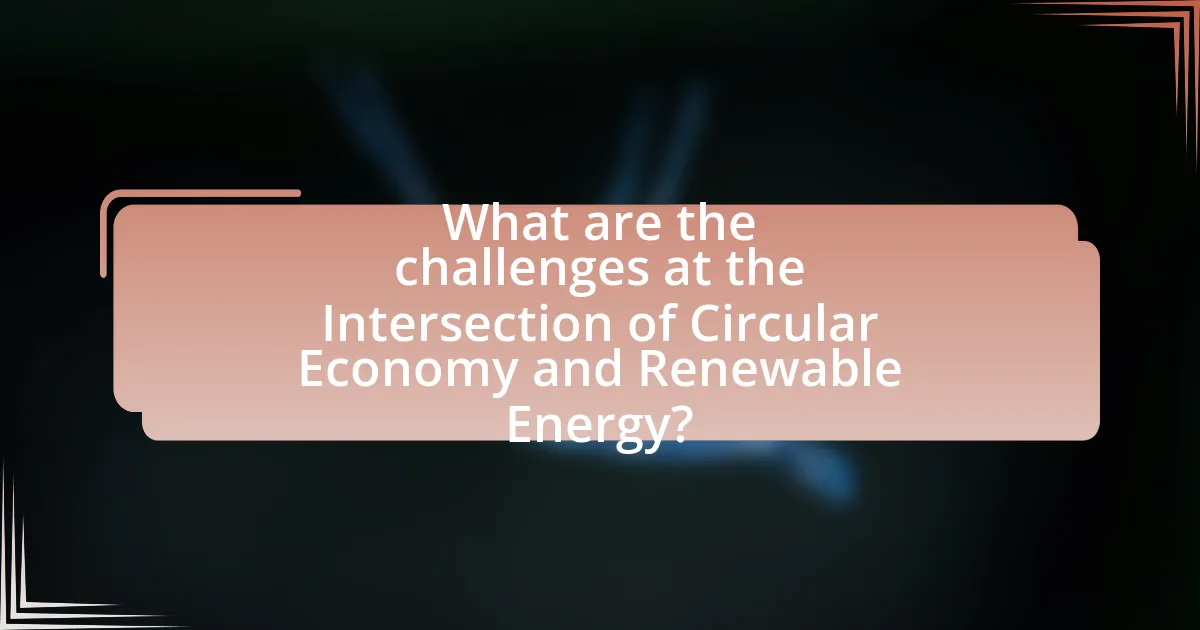
What are the challenges at the Intersection of Circular Economy and Renewable Energy?
The challenges at the intersection of circular economy and renewable energy include resource scarcity, technological integration, and economic viability. Resource scarcity arises as renewable energy technologies often require rare materials, which can be difficult to recycle or substitute. Technological integration poses a challenge because existing renewable energy systems may not be designed to accommodate circular economy principles, leading to inefficiencies. Economic viability is also a significant hurdle, as the initial investment for circular practices in renewable energy can be high, and the return on investment may not be immediately apparent. These challenges highlight the need for innovative solutions and policies to effectively merge circular economy concepts with renewable energy initiatives.
What barriers exist in implementing Circular Economy practices in Renewable Energy sectors?
Barriers in implementing Circular Economy practices in Renewable Energy sectors include technological limitations, regulatory challenges, and economic factors. Technological limitations arise from the lack of advanced recycling processes and infrastructure necessary for efficient material recovery from renewable energy systems, such as solar panels and wind turbines. Regulatory challenges stem from inconsistent policies and standards across regions, which hinder the adoption of circular practices. Economic factors involve the high initial costs associated with transitioning to circular models, making it difficult for companies to invest in sustainable practices despite long-term benefits. These barriers collectively impede the effective integration of Circular Economy principles within the Renewable Energy sector.
How do regulatory frameworks impact the integration of these concepts?
Regulatory frameworks significantly influence the integration of circular economy principles and renewable energy initiatives by establishing guidelines that promote sustainable practices. These frameworks can incentivize businesses to adopt circular models through tax benefits, subsidies, or grants, thereby facilitating the transition to renewable energy sources. For instance, the European Union’s Circular Economy Action Plan encourages member states to implement policies that support waste reduction and resource efficiency, which directly impacts the adoption of renewable energy technologies. Additionally, regulations that mandate renewable energy usage in production processes can drive companies to innovate and integrate circular economy strategies, ensuring that resources are reused and recycled effectively.
What technological challenges hinder progress in this area?
Technological challenges that hinder progress in the intersection of circular economy and renewable energy include inadequate recycling technologies, limited energy storage solutions, and insufficient integration of renewable energy systems. Inadequate recycling technologies restrict the efficient recovery of materials from renewable energy systems, such as solar panels and wind turbines, which impedes the circular economy’s goal of resource efficiency. Limited energy storage solutions hinder the ability to store excess renewable energy for later use, affecting the reliability and stability of energy supply. Insufficient integration of renewable energy systems into existing infrastructure complicates the transition to a circular economy, as it requires significant upgrades and investments in technology. These challenges collectively slow down the advancement of sustainable practices in both sectors.
How can stakeholders overcome these challenges?
Stakeholders can overcome challenges in the intersection of circular economy and renewable energy by fostering collaboration and implementing innovative practices. Collaborative efforts among businesses, governments, and communities can lead to shared resources and knowledge, enhancing efficiency and reducing costs. For instance, partnerships can facilitate the development of renewable energy technologies that utilize recycled materials, thereby promoting sustainability. Additionally, stakeholders can adopt circular economy principles, such as designing products for longevity and recyclability, which can mitigate waste and optimize resource use. Evidence from the Ellen MacArthur Foundation highlights that transitioning to a circular economy could generate $4.5 trillion in economic benefits by 2030, demonstrating the potential for stakeholders to achieve both environmental and economic gains through these strategies.
What role do governments play in facilitating this integration?
Governments play a crucial role in facilitating the integration of circular economy principles with renewable energy initiatives. They establish regulatory frameworks that promote sustainable practices, incentivize investments in renewable technologies, and support research and development in both sectors. For instance, policies such as tax credits for renewable energy projects and grants for circular economy innovations encourage businesses to adopt sustainable practices. Additionally, governments can implement standards and guidelines that ensure the efficient use of resources, thereby fostering a synergistic relationship between renewable energy and circular economy strategies. This approach not only enhances environmental sustainability but also drives economic growth, as evidenced by the European Union’s Green Deal, which aims to make Europe climate-neutral by 2050 through integrated policies that support both renewable energy and circular economy initiatives.
How can businesses innovate to align with Circular Economy principles?
Businesses can innovate to align with Circular Economy principles by adopting sustainable design practices, implementing resource recovery systems, and fostering collaborative consumption models. Sustainable design involves creating products that are durable, easily repairable, and recyclable, which reduces waste and extends product life cycles. For instance, companies like Patagonia have successfully integrated repair services into their business model, encouraging customers to maintain and reuse products rather than discard them.
Implementing resource recovery systems allows businesses to reclaim materials from end-of-life products, thus minimizing the need for virgin resources. An example is the electronics company Dell, which has established a closed-loop recycling system that reuses plastics from old devices in new products.
Fostering collaborative consumption models, such as sharing platforms or product-as-a-service offerings, can also drive innovation. Companies like Zipcar exemplify this by providing car-sharing services that reduce the number of vehicles on the road, thereby lowering resource consumption and waste. These strategies collectively support the transition to a Circular Economy by promoting sustainability and resource efficiency.
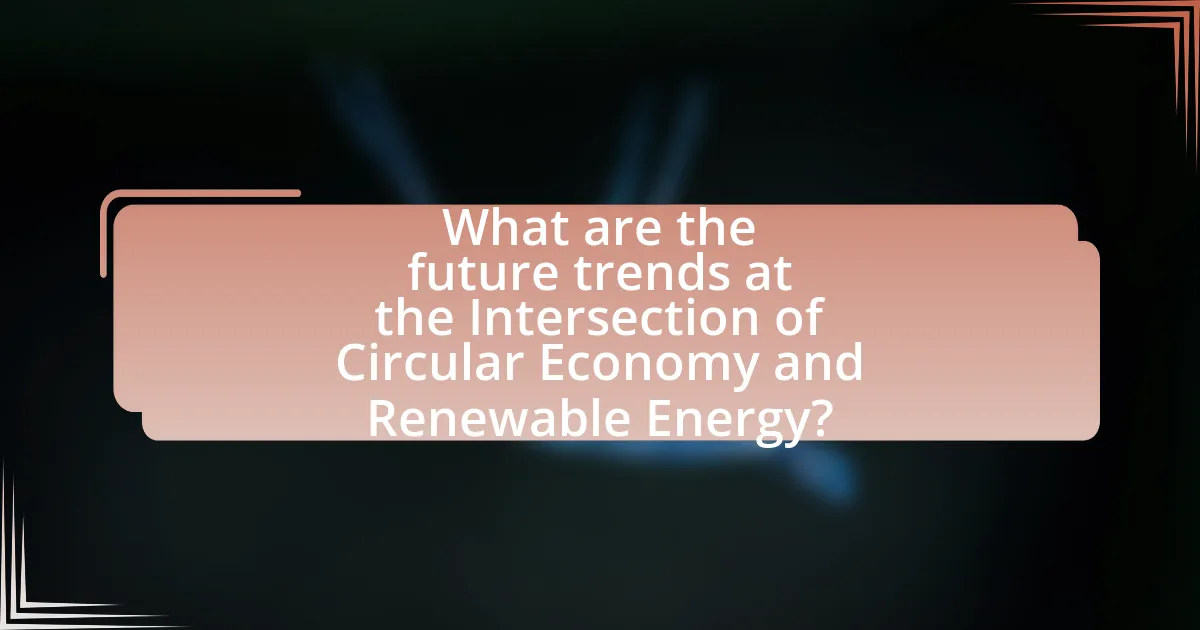
What are the future trends at the Intersection of Circular Economy and Renewable Energy?
Future trends at the intersection of circular economy and renewable energy include increased integration of waste-to-energy technologies, enhanced recycling of renewable energy components, and the development of energy-efficient systems that utilize renewable resources. The adoption of waste-to-energy technologies is projected to grow, as they convert waste materials into usable energy, thereby reducing landfill use and promoting resource recovery. Additionally, the renewable energy sector is increasingly focusing on recycling materials such as solar panels and wind turbine blades, with estimates suggesting that by 2030, the recycling market for these components could reach billions of dollars. Furthermore, energy-efficient systems that leverage renewable resources are expected to become more prevalent, driven by advancements in smart grid technologies and energy storage solutions, which facilitate the efficient use of renewable energy while minimizing waste.
How is technology shaping the future of this intersection?
Technology is shaping the future of the intersection of circular economy and renewable energy by enabling more efficient resource management and energy production. Innovations such as advanced recycling technologies, smart grids, and IoT applications facilitate the integration of renewable energy sources while minimizing waste. For instance, the development of blockchain technology allows for transparent tracking of materials in a circular economy, ensuring that resources are reused effectively. Additionally, research from the Ellen MacArthur Foundation highlights that transitioning to a circular economy could generate $4.5 trillion in economic benefits by 2030, demonstrating the significant impact of technology in this area.
What emerging technologies are most promising for enhancing Circular Economy in Renewable Energy?
Emerging technologies that are most promising for enhancing Circular Economy in Renewable Energy include advanced recycling processes, digital twins, and blockchain technology. Advanced recycling processes, such as chemical recycling, enable the breakdown of materials into their original monomers, allowing for the creation of new products without degrading quality. Digital twins facilitate real-time monitoring and optimization of renewable energy systems, improving efficiency and resource management. Blockchain technology enhances transparency and traceability in supply chains, ensuring that materials are reused and recycled effectively. These technologies collectively support the principles of the Circular Economy by minimizing waste and maximizing resource utilization in renewable energy sectors.
How can data analytics improve efficiency in this context?
Data analytics can improve efficiency in the intersection of circular economy and renewable energy by optimizing resource allocation and enhancing decision-making processes. By analyzing data on resource usage, waste generation, and energy consumption, organizations can identify inefficiencies and areas for improvement. For instance, a study by the Ellen MacArthur Foundation highlights that data-driven insights can lead to a 30% reduction in material costs and a significant decrease in energy consumption through better supply chain management. This demonstrates that leveraging data analytics not only streamlines operations but also supports sustainability goals within the circular economy framework.
What best practices can be adopted for effective integration?
Effective integration of circular economy principles with renewable energy can be achieved through several best practices. First, organizations should prioritize designing products for longevity and recyclability, which reduces waste and maximizes resource efficiency. For instance, the Ellen MacArthur Foundation emphasizes that designing for circularity can lead to a 70% reduction in resource use. Second, implementing closed-loop systems allows for the recovery and reuse of materials, thereby minimizing the need for new resources. Research from the World Economic Forum indicates that circular practices can generate $4.5 trillion in economic benefits by 2030. Third, fostering collaboration among stakeholders, including businesses, governments, and communities, enhances knowledge sharing and resource optimization. A study by Accenture found that cross-sector partnerships can accelerate the transition to a circular economy by 30%. Lastly, investing in renewable energy technologies, such as solar and wind, supports sustainable practices and reduces carbon footprints, aligning with circular economy goals.
What strategies can organizations implement to promote Circular Economy in Renewable Energy?
Organizations can implement strategies such as designing for longevity, enhancing recycling processes, and fostering collaboration across the supply chain to promote Circular Economy in Renewable Energy. Designing for longevity involves creating renewable energy systems that are durable and easy to repair, which reduces waste and extends product life. Enhancing recycling processes ensures that materials from decommissioned renewable energy systems, like solar panels and wind turbines, are effectively recovered and reused, minimizing resource extraction. Fostering collaboration across the supply chain encourages stakeholders to share best practices and innovations, leading to more efficient resource use and waste reduction. These strategies align with the principles of the Circular Economy, which aims to keep resources in use for as long as possible, thereby supporting sustainable energy practices.
How can collaboration between sectors enhance outcomes?
Collaboration between sectors can enhance outcomes by leveraging diverse expertise and resources to drive innovation and efficiency. For instance, partnerships between the renewable energy sector and waste management organizations can lead to the development of technologies that convert waste into energy, thereby reducing landfill use while generating clean power. A study by the Ellen MacArthur Foundation highlights that such collaborations can lead to a 30% reduction in resource consumption and a significant decrease in greenhouse gas emissions. This demonstrates that cross-sector collaboration not only fosters sustainable practices but also creates economic opportunities, ultimately leading to improved environmental and social outcomes.
What practical steps can individuals take to support this intersection?
Individuals can support the intersection of circular economy and renewable energy by adopting sustainable consumption practices. This includes reducing waste by choosing products with minimal packaging, opting for reusable items, and recycling materials to extend their lifecycle. Additionally, individuals can invest in renewable energy sources, such as solar panels for their homes, which not only decrease reliance on fossil fuels but also promote a circular economy by utilizing renewable resources. Supporting local businesses that prioritize sustainability and circular practices further enhances this intersection, as it fosters a community focused on environmental responsibility. According to the Ellen MacArthur Foundation, transitioning to a circular economy could generate $4.5 trillion in economic benefits by 2030, highlighting the significant impact of individual actions in this area.
